
Abandoned & Little-Known Airfields:
Colorado: Southeastern Denver area
© 2002, © 2016 by Paul Freeman. Revised 1/30/16.
This site covers airfields in all 50 states: Click here for the site's main menu.
The CO pages of this website are sponsored by the Colorado Pilots Association:
____________________________________________________
Please consider a financial contribution to support the continued growth & operation of this site.
East Colfax Airport / Columbine Airport / Aurora Airpark (revised 4/26/14) - Lowry Field (2ndlocation) / Lowry AFB (revised 1/30/16)
____________________________________________________
East Colfax Airport / Columbine Airport / Aurora Airpark (01V), Aurora, CO
39.73, -104.65 (East of Denver, CO)
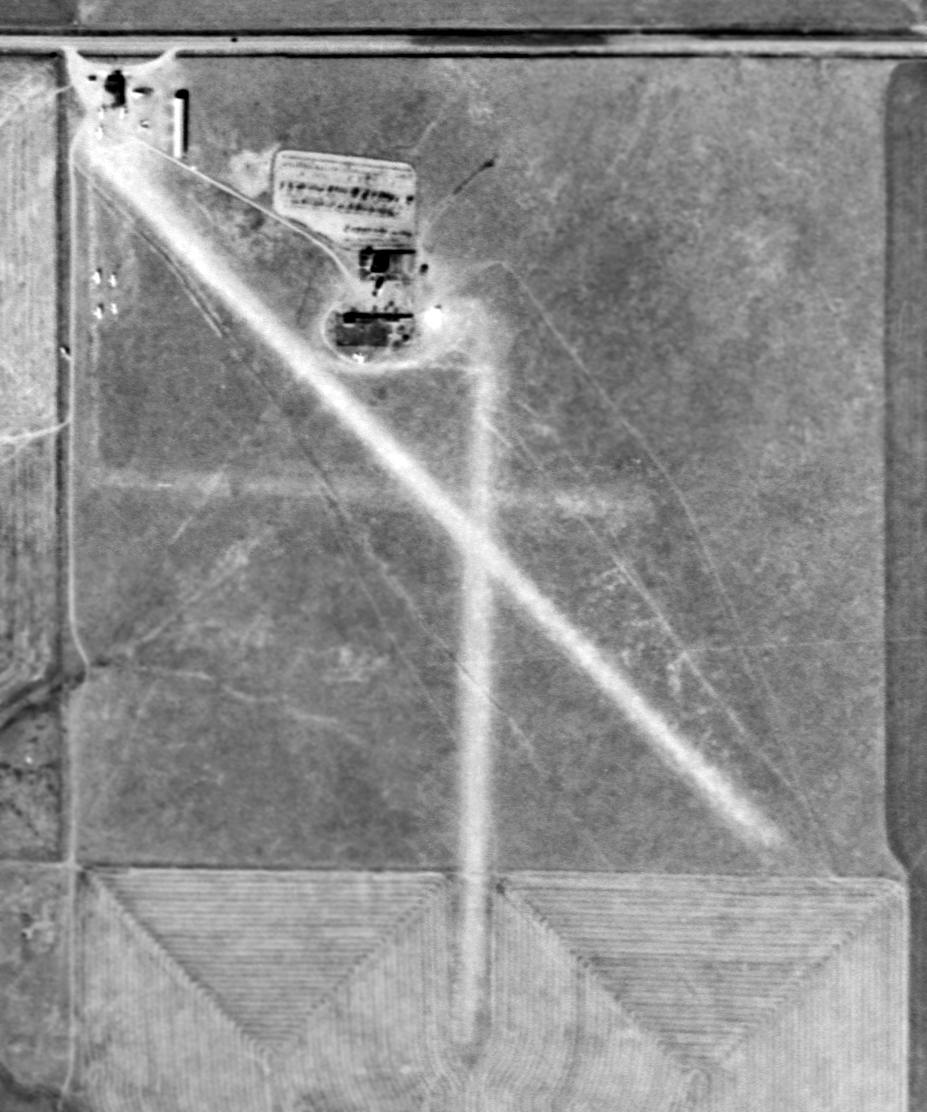
A 10/21/48 USGS aerial photo of East Colfax Airport.
This general aviation airport was apparently built at some point between 1945-48,
as it was not yet depicted on the February 1945 Denver Sectional Chart (courtesy of Richard Doehring).
The earliest depiction which has been located of East Colfax Airport was on a 10/21/48 USGS aerial photo.
It depicted East Colfax" Airport as having 3 unpaved runways, with a half-dozen light aircraft & a few small buildings on the northwest side.
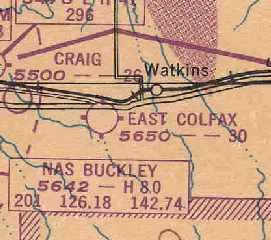
The earliest aeronautical chart depiction which has been located of East Colfax Airport
was on the February 1949 Denver Sectional Chart (courtesy of Chris Kennedy).
It depicted East Colfax as having a 3,000' unpaved runway.
East Colfax's runway was lengthened at some point between 1949-63,
as the October 1963 Sangre De Christo Mountains World Aeronautical Chart(courtesy of Donald Felton)
depicted the field as having a 5,000' unpaved runway.
East Colfax Airport was depicted in the 1967 Flight Guide(courtesy of Chris Kennedy)
as having 2 unpaved runways: 5,000' Runway 13/31 & 2,550' Runway 7/25.
Several taxiways led to a cluster of hangars on the north side of the field,
and there was also another line of small hangars on the west side of the field.
The field was said to conduct skydiving operations.
Tom Richards recalled of East Colfax Airport, "I learned to fly there in the late 1960s
and kept my Cessna 120 tied down there until I sold it in 1970.
It was a great place in those days. Denver was about half the size it is now.
Flying out of East Colfax was basically unrestricted.
The only real problem we had was of course Stapleton and sometimes Buckley ANG Base."
"East Colfax" Airport was depicted on the 1970 Denver Sectional Chart(courtesy of Vince Granato)
as having a 5,000' unpaved runway.

At some point between 1970-76, the field was apparently renamed Columbine Airport,
that is how it was labeled on the 1976 USGS topo map.
That must have caused confusion, as there was also anotherColumbine Airportin nearby Littleton.
It was depicted as having a single runway, oriented northwest/southeast.
According to John DeBrouwer, “Vaughn Cole of Cole Aviation carried the airport name from Littleton to Aurora.”
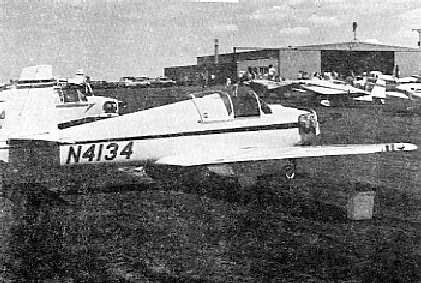
A 1976 photo by Larry Dale of a Mooney M-18L Mite at Columbine Airport.
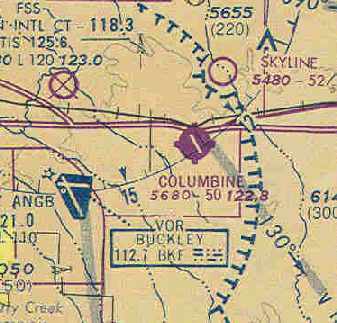
The February 1977 Denver Sectional Chart (courtesy of Chris Kennedy)
depicted Columbine Airport as having a single 5,000' paved runway.
The 1982 AOPA Airports USA directory(courtesy of Ed Drury)
described Columbine Airport in Aurora as having a 5,000' asphalt Runway 14/32
and a 2,550' dirt Runway 7/25.
The field was said to offer fuel, major repairs, tiedowns, hangars, charter, flight instruction, and plane rental.

At some point between 1982-89 the field was renamed again, this time to Aurora Airpark.
The June 1989 Denver Terminal Chart (courtesy of Robert Brown) depicted Aurora as having a single 4,700' paved runway.
The 1992 Flight Guide(courtesy of Chris Kennedy)depicted Aurora as having a 4,687' paved runway 14/32
and a 2,300' dirt Runway 8/26 (which was closed to transient aircraft).
A large number of small hangars were depicted on the northwest & northeast sides of the field.
The field was said to conduct operations by ultralight aircraft & cropdusters.

As seen in the 1993 USGS aerial photo,
two ramp areas northwest & northeast of the runway intersection had a large number of individual T-hangars,
as well as a substantial number of aircraft visible parked outside.
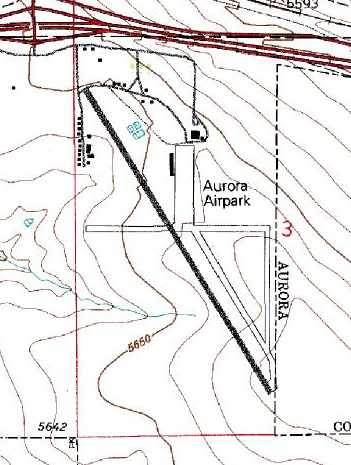
By 1998, the USGS topo map showed that the airport had been renamed Aurora Airpark.
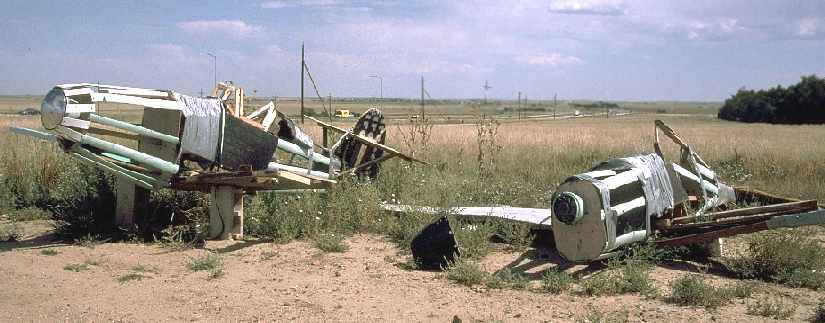
A September 17, 2000 photo by AirNikon of what appears to have been 2 homebuilt aircraft, abandoned before their completion.
The photo was taken behind a gas station adjacent to Aurora Airpark.
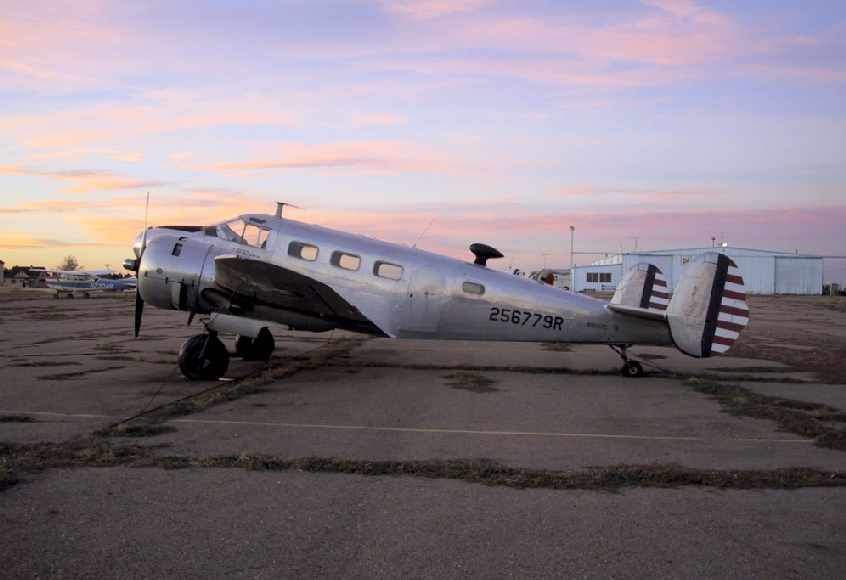
A beautiful sunset picture by Fabian Lorentz of a Beech 18 (N95622, "immaculate inside & out"),
caught at Aurora Airpark on October 19, 2001.

A September 2003 aerial photo by AirNikon looking west at the Aurora Airpark ramp,
with at least 10 aircraft visible parked outside.
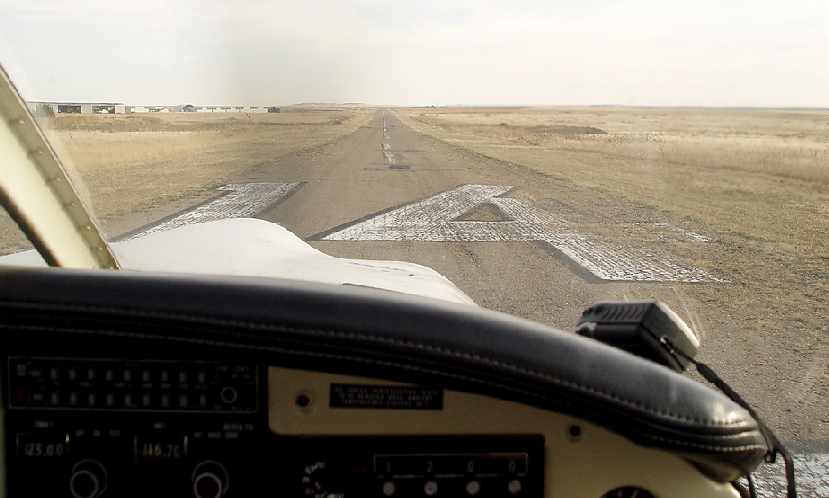
A November 9, 2003 photo by Craig Mills, departing from Aurora Airpark's Runway 14 in a Piper Arrow.
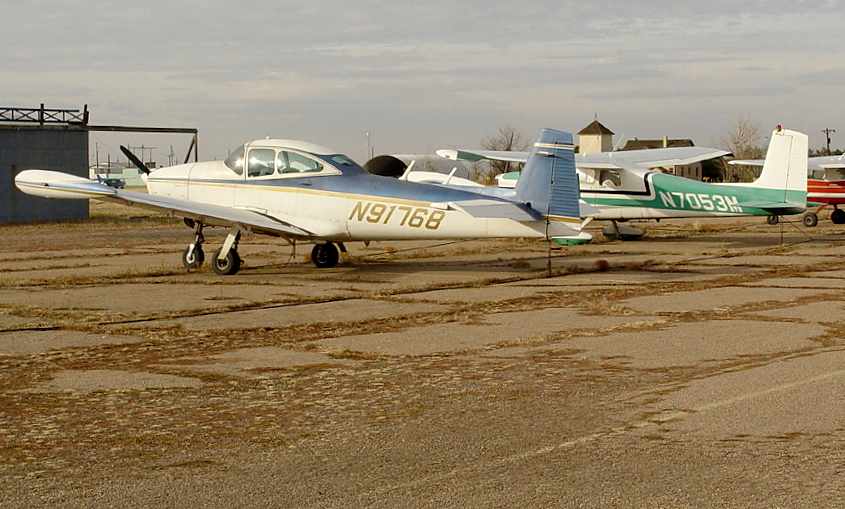
A November 9, 2003 photo by Craig Mills of a Navion & 2 Cessnas at Aurora Airpark.

A June 3, 2004 photo by Craig Mills looking southeast along Aurora Airpark's Runway 14 in its final days.
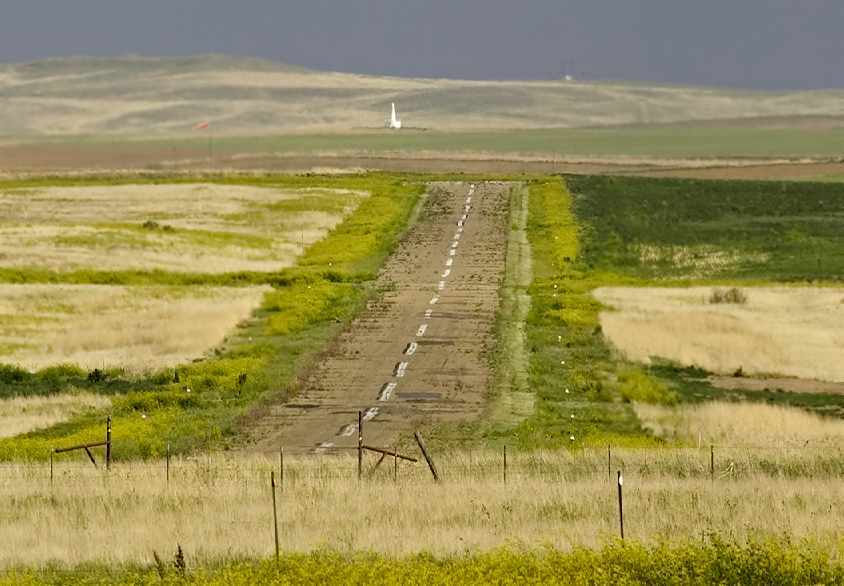
A June 3, 2004 photo by Craig Mills looking southeast along Aurora Airpark's Runway 14,
with the Falcon VOR visible in the background.
Scott Krugerud recalled of Aurora Airpark, “My family kept our Cessna 210 there until it closed,
forcing us to move to nearby FTG.
While our plane is better off for it (FOD from gravel on the runway = prop that looks like a cheese grater), I miss the place.
It was run like a small town, everybody knew each other.
Many different activities took place there other than aviation.
We were allowed to shoot trap off the end of one of the dirt runways,
our only warning was to 'not shoot any planes'.”
Unfortunately, the pace of suburban development caught up with the little Aurora Airpark in 2004,
as explained by Craig Mills.
"I only know about the field closing because my friend based his Arrow there.
He's flown out of there for a long time & because it is a privately owned airport,
there has been lots of interest in eventually developing it into some kind of commerce buildings.
The sticking issue was water rights,
but those just recently got cleared up,
so the go ahead to close the field has been given.
The date of closure is July 15th[2004]."
The closure of Aurora Airpark was also probably somewhat precipitated
by the construction of the huge new Denver International Airport,
located a mere 5 miles to the north of the little Aurora Airpark.
The little airport was also situated underneath DIA's Class B airspace,
which came down to only 200' above Aurora's traffic pattern altitude(according to Aurora pilot Richard Werry).
In its last year of operation (2004), thepublished data for Aurora Airpark
described the field as having a 4,800 asphalt Runway 14/32
(which was unfortunately described as "in poor condition;
Pavement surface uneven with loose aggregate from Runway 14 end to midpoint"),
as well as a 2,300' turf/dirt Runway 8/26 (described as "in fair condition").
It is sad to see this airport going away - as it was obviously well used,
with a total of 78 aircraft listed as being based on the field (including 3 multi engine aircraft & 1 helicopter),
and the field was said to conduct an average of 60 takeoffs or landings per day.
Bob Resling reported that at the time of Aurora's closure,
“It was the oldest continuously operated airport in Colorado at the time.”
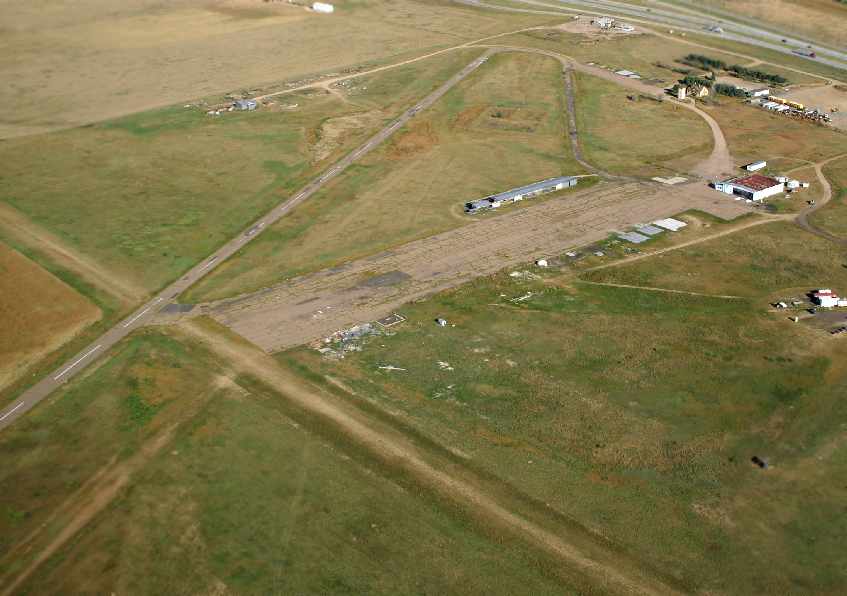
A September 18, 2004 photo by Craig Mills looking northwest at the abandoned Aurora Airpark.
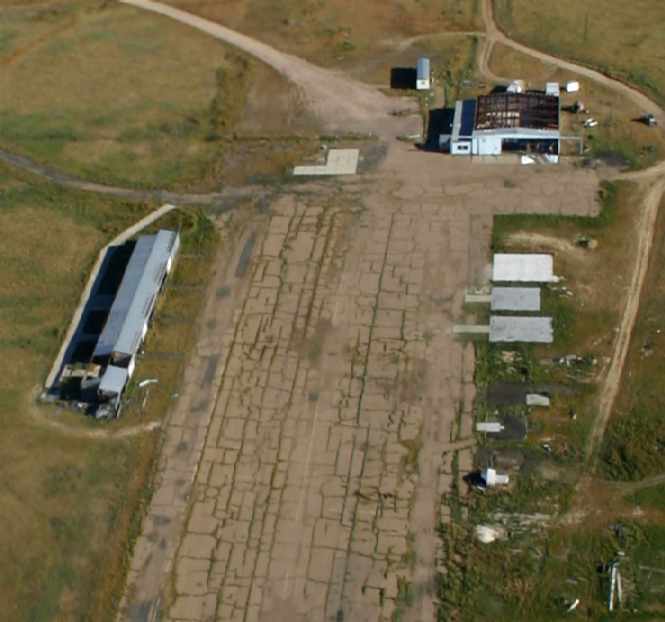
A sad September 18, 2004 photo by Craig Mills, looking north at the abandoned hangars of Aurora Airpark.
Scott Krugerud reported in 2005, “My family & I still take our dogs out there to run in the open space.
As of yet, no construction has started and it will be some time until it does.
There is trash everywhere, mostly leftovers from the cheap hangars.
My understanding is that is the reason the airport was closed.
It had been for sale for many years.
The zoning commission in Arapahoe county had petitioned to rezone quite some time before, but nothing was ever done.
I heard that the property owners did not appreciate the trash
(broken down cars, RVs, and just plain junk) that had collected on the premesis.
The junk is still there, but the planes are gone.
Most of the hangars are gone now.
Only the shells of the tin roofed hangars next to Runway 14 are still there.
When the large hangar was brought down, all of the insulation & junk from inside was allowed to blow across the property.”
“In my opinion, the property is going to sit for some time.
I cannot imagine some investor looking to build a subdivision there with all of the cleanup
while there is virgin farmland on all sides that is also for sale.
The thought of living under the approach path for 35L at DEN would be somewhat less than appealing too.”
Heath Kennedy reported in 2005, “A preliminary development plan was approved by Arapahoe County
that allows for a mixed-use commercial, retail and residential development
to occur on roughly 900 acres that also includes the site of the old airport.
Construction should start within the next 2 years & is scheduled for a 10-15 year buildout.”
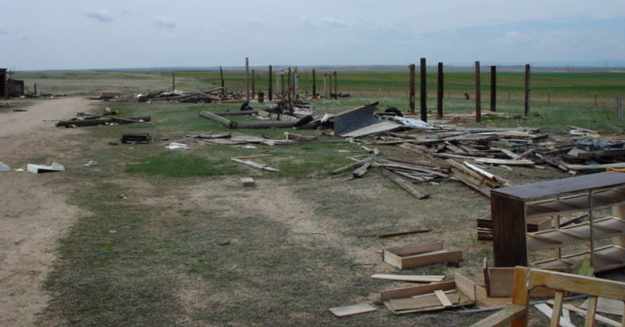
A 2005 photo by Keith Wood, of “what's left of the row of hangars on the west edge of the field.
There were some powered parachutes flying when I was there.”

A 2006 photo by Patrick Griffith looking southeast along the former Runway 14 of Aurora Airpark.
Patrick Griffith reported in 2006, “I stopped by the old Aurora Airpark site today.
Not much has happened there recently. All of the old structures are down.
There was a large Public Notice sign giving notice of a plan to build the 'Sky Ranch Wastewater Treatment Plant'.
There was also a sign announcing the 'Neighborhood of Sky Ranch' coming soon
[which is somewhat confusing, given that 'Sky Ranch' is the name of another former airport, located somewhat to the northeast].
What a great place this would be for ultralight & powered parachute operations!”
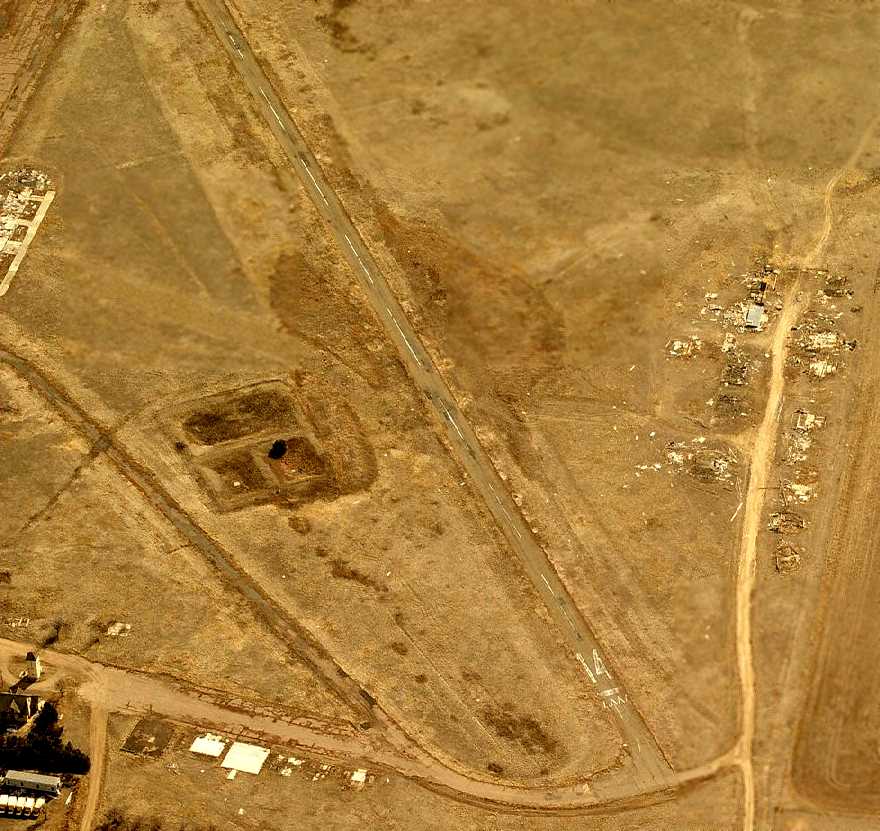
A circa 2006 aerial view looking south along Aurora's Runway 14, showing the wreckage from demolished hangars.
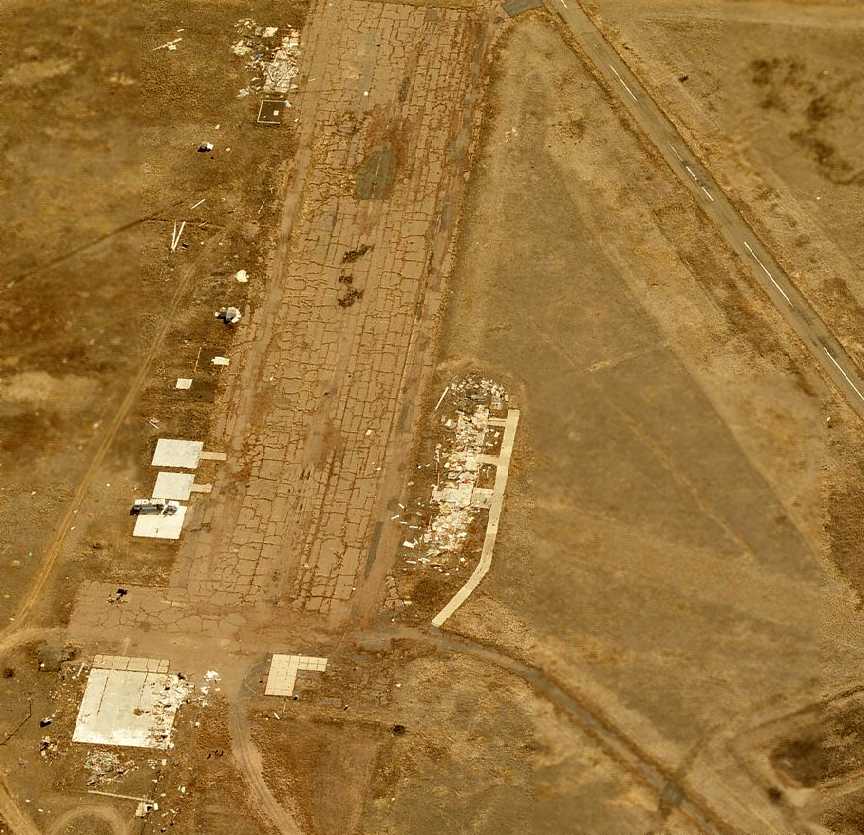
A circa 2006 aerial view looking south at the foundations of Aurora's former hangars.
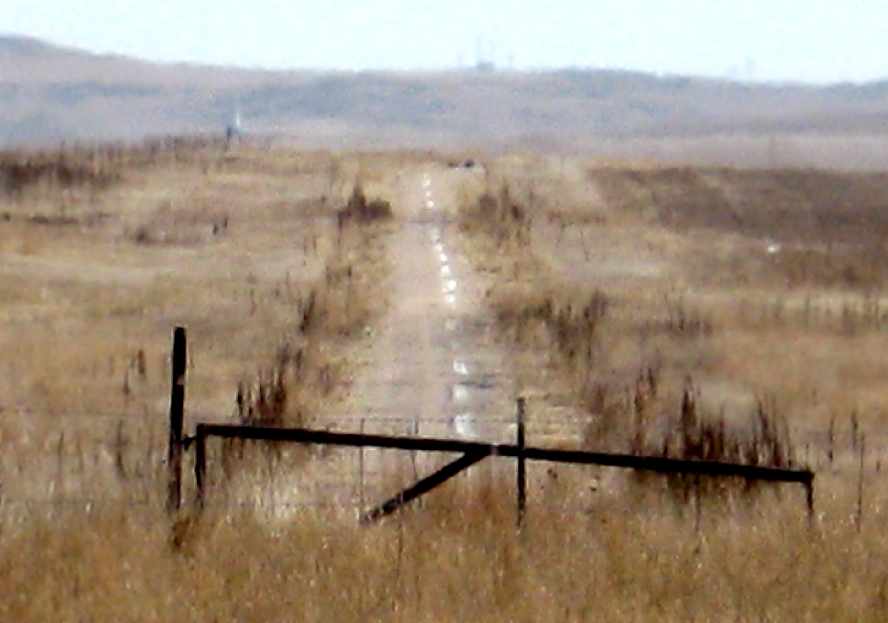
A March 2008 photo by Raymond Cober looking southeast along the former Runway 14 of Aurora Airpark.
Raymond observed, “Despite the poor condition of the runway
it looks like the only difference between this & when the airport was still active was that the grass was trimmed!
I remember my flight instructor forbidding me to do touch & go's on the runway because of its poor condition, just months before it was closed.”
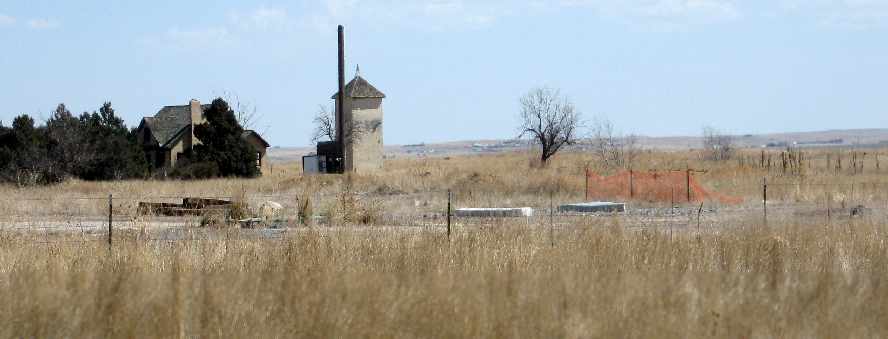
A March 2008 photo by Raymond Cober of the site of the gas station which used to sit adjacent to the Aurora Airpark,
where the 2 abandoned half-built kitplanes were located (in preceding photo).
Raymond observed, “The gas station also included a BBQ restaurant,
both of which had been abandoned for as long as I can remember, long before the airport's closure.
Like most of the airport structures, this site has been nearly completely removed as well.
A man by the name of Shawn Dougan (who happens to work at nearby Front Range Airport) came by & gave me more information.
We exchanged the usual aviation knowledge & camaraderie,
and he told me that there was a radio-controlled airplane club that had been active during the airport's operation,
and they still were, operating out of a purpose-built mini-airfield adjacent to the property [east of the airport].
Beyond the the large main hangar with its adjacent offices would've been visible.
In the background you can see a house & a tower along with a clump of trees.
I don't know what purpose the house & tower served in relation to the airport,
or whether or not their construction predates the airport or not.
I would guess the tower served to store grain or equipment, but it was sometimes jokingly referred to as the airport's ATC tower.
I do not recall if they were occupied when the field was in operation, but both were found in a derelict state when I photographed them.
The road that leads into the airfield bisects the clump of trees.
It was paved, but badly pitted & covered with nearly as many potholes as it had pavement.”
Aurora Airpark is located at the southern terminus of East Colfax Road,
along the south side of Interstate 70.
____________________________________________________
Lowry Field (2nd location) / Lowry AFB, Denver, CO
39.71, -104.89 (Southeast of Downtown Denver, CO)
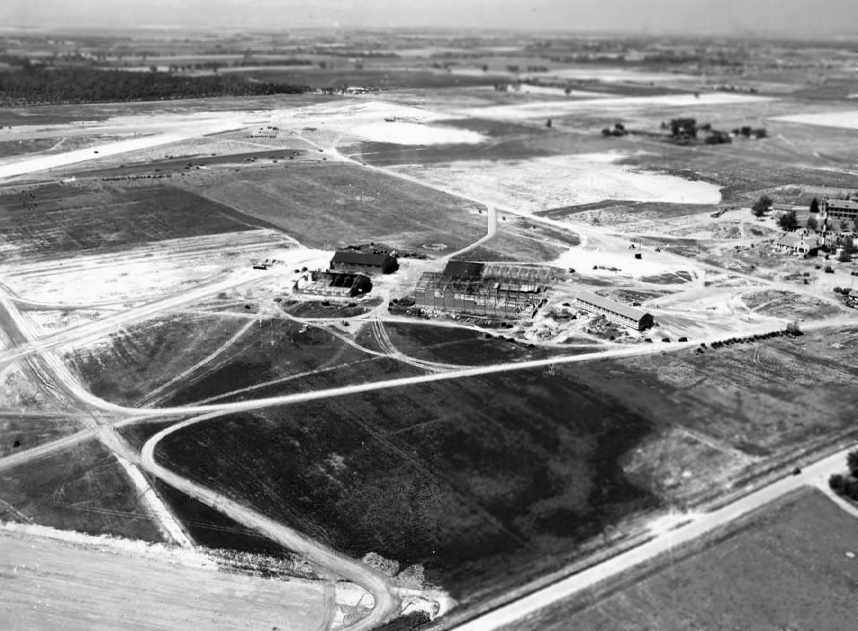
A 7/20/38 aerial view of Lowry Field (courtesy of David Brooks) showing the hangars & runways while under construction.
In 1934 the Army realized it was outgrowing its facilities at Chanute Field, IL
and began looking for a new facility where it could consolidate all of its Air Service Technical training schools.
After looking at more than 80 sites across the nation,
a military committee submitted a list to Congress with the names of 6 cities that would meet their needs.
Denver ranked first.
Congress approved the Air Corps project in 1937,
but Chanute remained the headquarters of the Air Corps Technical School & home to the aircraft mechanics school.
The Army formed a new branch for armament & photography training in Denver.
The Works Progress Administration began work October 4, 1937
to convert the grounds of the former Agnes Memorial Sanatorium into a modern airfield.
The new field was to be named in honor of Francis Lowry,
a Denver native who had been killed when he was shot down in 1918 while serving as an aerial observer.
Note that there was also a separate & unrelated airfield (4 miles to the northwest) known as"Lowry Field",
which was operated by the Colorado National Guard from 1924-38.
Once construction started on the new Lowry Field,
the Denver branch of the Army Air Corps became an Army post of 880 acres.
A bombing range of 64,000 acres was acquired in 1938.
In 1941, the Army acquired an additional 960 acres a few miles to the east
as an auxiliary landing field, and named it Buckley Field.
Classes at the new Lowry Field began on 2/28/1938.
Ten students graduated from the Armament Department on 3/19/1938.
Several months later, 10 photography students received diplomas in advanced aerial photography.
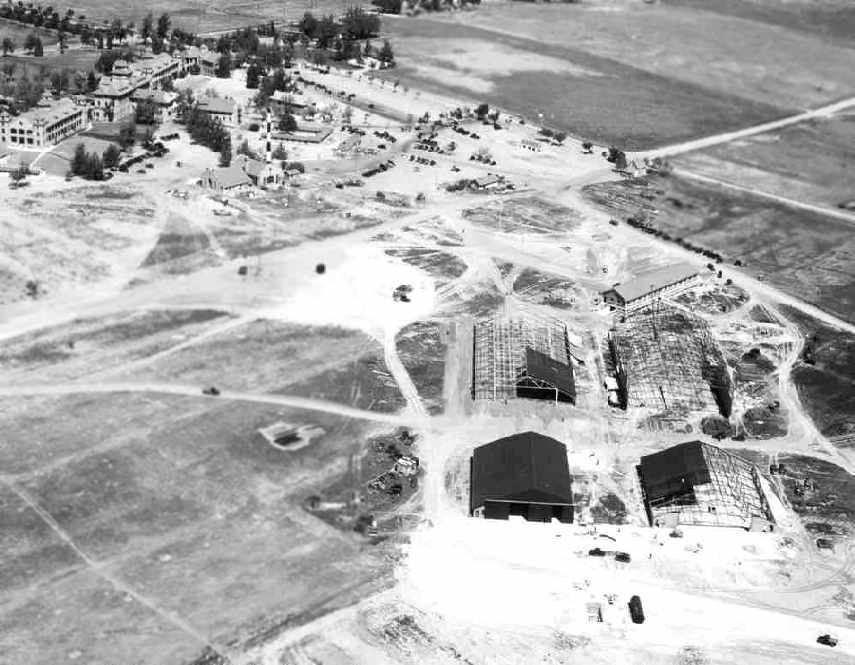
A 7/30/38 aerial photo (courtesy of David Brooks) showing the hangars & runways of the new Lowry Field while under construction.
While construction was underway, the Army kept aircraft assigned to the Denver branch at the Municipal Airport,
where they shared a hangar with the Colorado National Guard.
When Lowry’s first unpaved runway became operational on April 4, 1938,
the first of 4 portable National Guard hangars was erected.
On June 30, nine aircraft flew from Municipal Airport to Lowry Field.
Construction continued and Hangar #1 was completed in August 1939,
and the 8,000' north/south runway was completed in December.
The first aircraft to land on the new, paved runway was a B-18A Bolo twin-engine bomber.
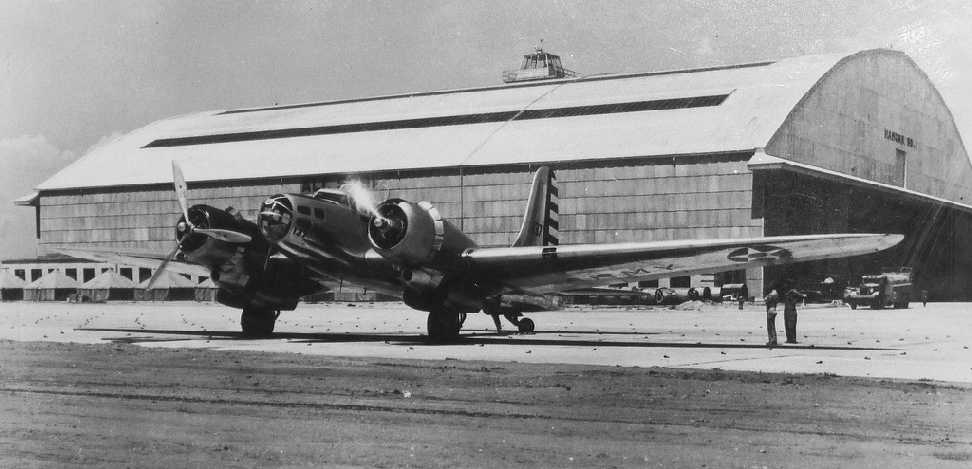
The earliest photo to be located showing an aircrat at Lowry Field was a 1939-40 photo of a Douglas B-23 Dragon bomber in front of a Lowry hangar.
In January 1940, Lowry Field had a complement of 44 officers,
1,350 enlisted men including 600 students, and 27 aircraft.
As the international situation worsened, the Army acquired additional land.
Following December 7, 1941, the inflow of trainees increased.
In January 1942, the War Department tasked Lowry with annually training 57,000 men.
To accommodate the larger student population, construction of Lowry Field #2 was begun.
Lowry #2 was built on the northeast side of the post beyond 6thAvenue.
It opened in July 1942.
In addition, Armament School #2 was established at Buckley Field.
Lowry trained only bombardment armorers while Buckley prepared armorers for fighter aircraft.

A 1943 street map (courtesy of Rex Ricks) depicted Lowry Field's original runway arrangement, with 2 perpendicular runways with several hangars to the northwest.
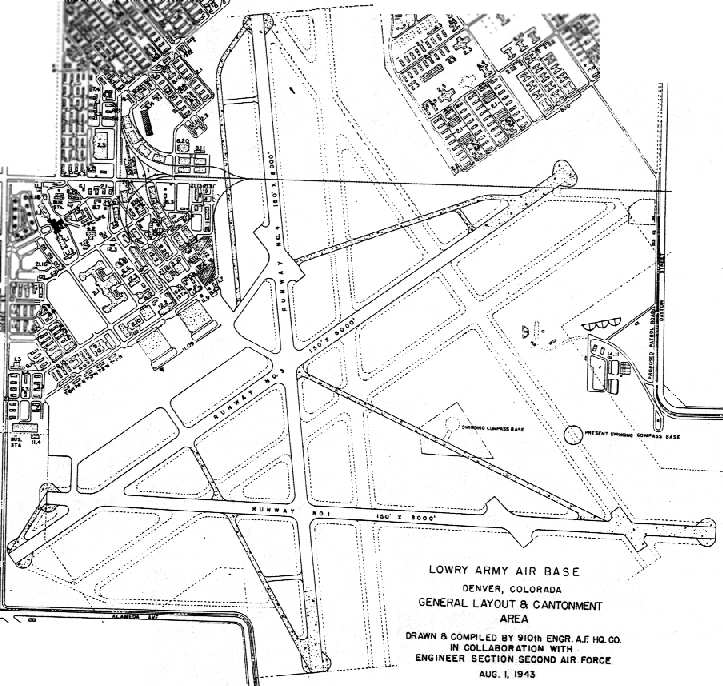
A 1943 2nd Air Force General Layout Plan (courtesy of John Voss)
depicted Lowry Field as having a considerably expanded runway configuration, with three 8,000' paved runways, taxiways, a ramp with 2 large hangars,
and a cantonment area with hundreds of buildings on the north side of the airfield.
The plan also depicted a planned addition of 3 other runways, but these were apparently never built.
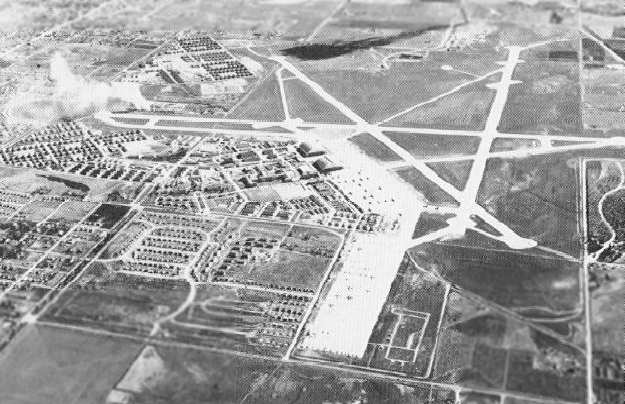

A 1943 aerial view of Lowry Field.
In October 1943, Lowry Flight Engineers School was moved to Lowry.
In 1944, Lowry introduced courses in radar photography, autopilot maintenance, and B-29 crew training.
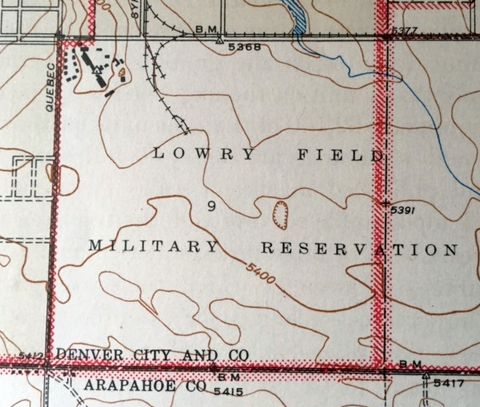
The 1944 USGS topo map (courtesy of Kevin Walsh)
depicted “Lowry Field Military Reservation” as a blank area, presumably due to wartime security concerns.
In April 1945, the Crash Fire Fighting & Rescue School moved to Lowry from Buckley Field.
Also in 1945, production of B-29 Superfortresses reached a level
that necessitated another school for pilot & crew training.
Forty-two B-29s arrived at Lowry in May & the 6-week course began in July.
At war’s end, 2 classes remained at Lowry along with 39 Superfortresses.
The classes never completed training.
The end of the war in Europe in May & V-J Day on August 15
ended Lowry’s short history as a pilot transition training school.
Lowry quickly returned to a peacetime schedule.
Staffing decreased & student enrollment plummeted.
It became a separation center for returning veterans.
By the end of the 1945, Lowry was processing an average of 300 discharges a day.
In 1948, with the postwar reorganization of the military,
Lowry Field became Lowry Air Force Base.
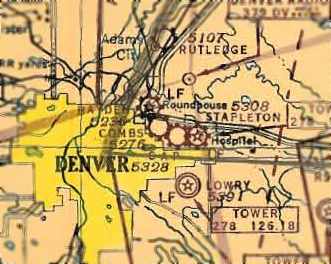
The February 1945 Denver Sectional Chart (courtesy of Richard Doehring)
depicted Lowry as a military airfield.
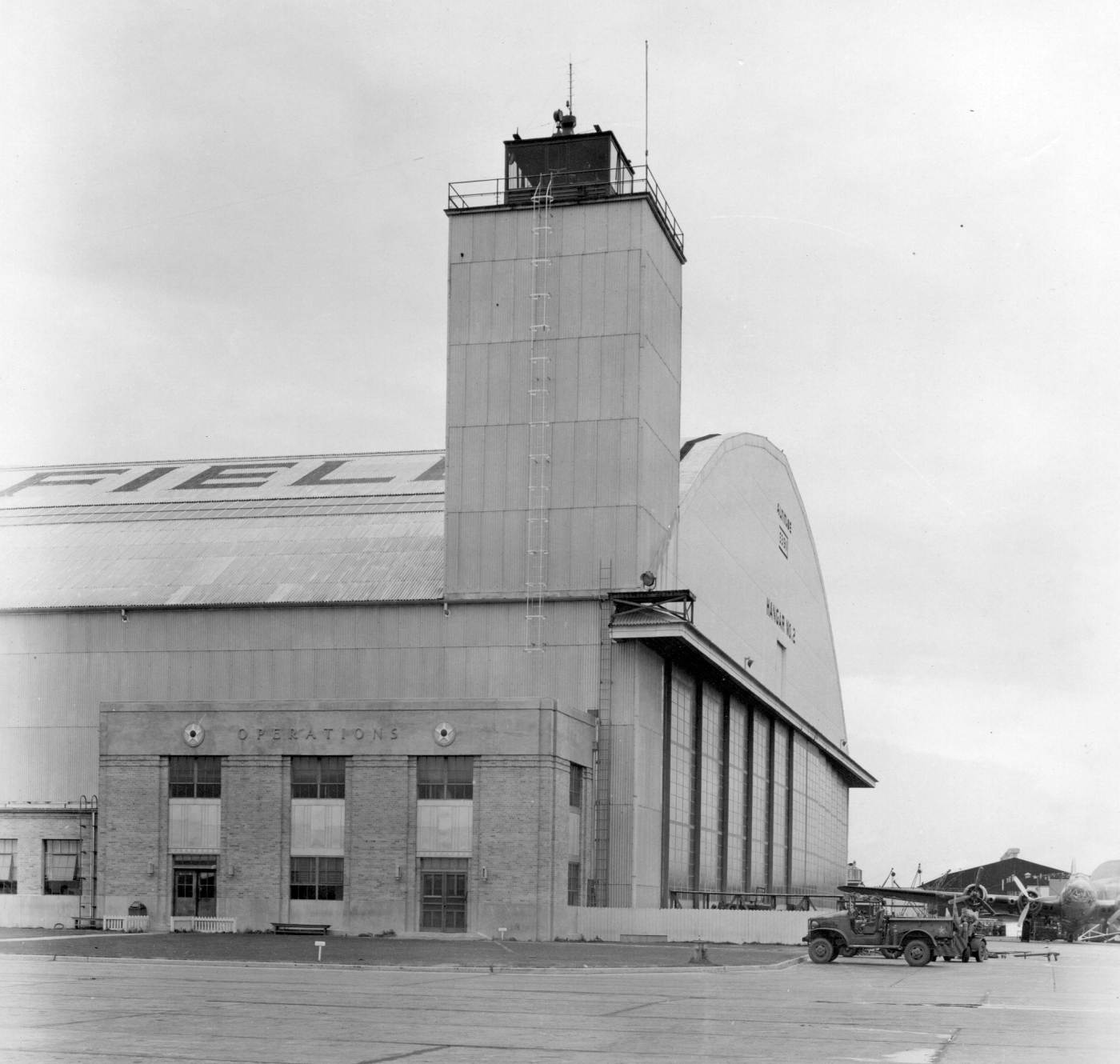
A 1946-49 photo by Bruce Reid (courtesy of Don Reid) of the Lowry Field Operations building, control tower, and Hangar #2.
Note the early-model B-17 at bottom-right.

A 1946-49 photo by Don Reid (courtesy of Bruce Reid) of the interior of the Lowry Field control tower.
Bruce reported that his father, Don Reid, “was tasked with coming up with a standard console design for all towers of that era.
It was based on feedback provided by those tower operators from around the country. Their comments had a great impact on the final design.”
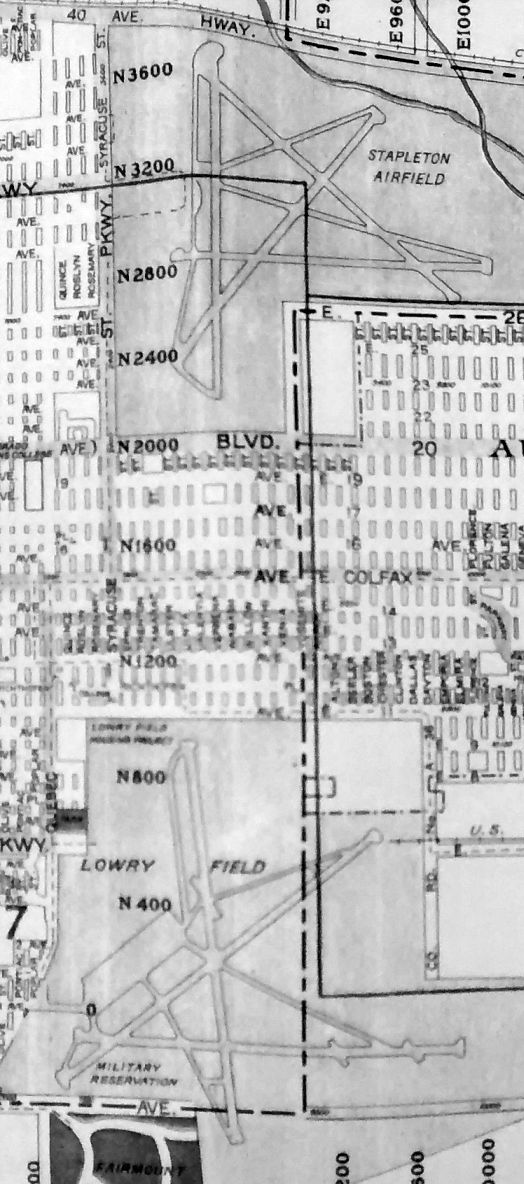
A 1948 street map (courtesy of Rex Ricks) depicted Lowry Field's proximity to Stapleton Airfield.

The February 1949 Denver Sectional Chart (courtesy of Chris Kennedy)
depicted Lowry AFB as having an 8,300' hard surface runway.
Paul Goebel recalled, “Lowry Air Force Base... In 1951, there was heavy traffic of B-36 planes taking off & landing.
They had a unique sound with their combination of radial piston engines & jets.”
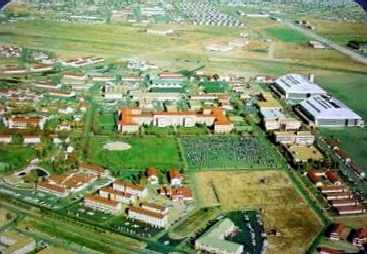
A 1950s postcard aerial view looking east at Lowry AFB (courtesy of Rex Ricks).
In the 1950s Lowry AFB immediately responded to the North Korean incursion with an expanded training program.
Courses taught, in addition to photography & armament,
included rocket propulsion, missile guidance, electronics, radar-operated fire-control systems,
computer specialties, gun & rocket sights, and electronically operated turret systems.
Lowry lost one of its traditional courses, aerial photography, in February 1956.
Changing technology in the form of remote-control cameras on reconnaissance aircraft
made aerial photography specialists redundant.
Programs in camera repair & ground photography, however, continued to be taught.
In 1954, President Eisenhower signed a bill authorizing an Air Force Academy.
Lowry was selected as the Academy’s interim home until construction was completed in Colorado Springs.
The first class of cadets arrived in July 1955.
Paul Goebel recalled, “Lowry Air Force Base... In 1955, it was being used by fighter jets.”
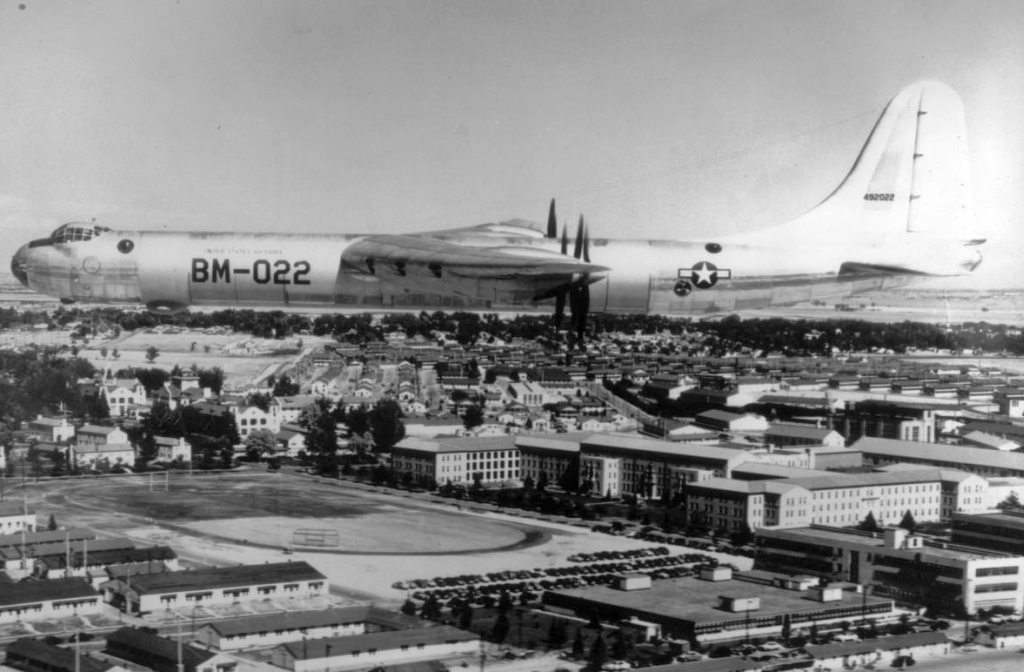
A circa 1950s aerial view of a massive Convair B-36 Peacemaker bomber overflying Lowry AFB.
The Air Force Academy occupied facilities at Lowry #2 until 1958.
The 1960s marked the end of an era at Lowry.
The 3415thTechnical Training Wing became Lowry Technical Training Center.
Headquarters shifted from the Sanatorium buildings.
Flight activity began to be phased out,
in part due to the dense encroachment of residential development around Lowry AFB,
which had made it increasingly unsuitable for flight operations.
The base was closed to all transient air traffic in June 1960.
The 451stStrategic Missile Wing operated 2 HGM-25A Titan I equipped missile squadrons from its Lowry support base.
The 724thStrategic Missile Squadron operated 3 missile sites from 2/1/60-1/25/65: 724-A, 724-B, and 724-C.
The 725thStrategic Missile Squadron operated 3 missile sites from 8/1/60-1/25/65: 725-A, 725-B, and 725-C.
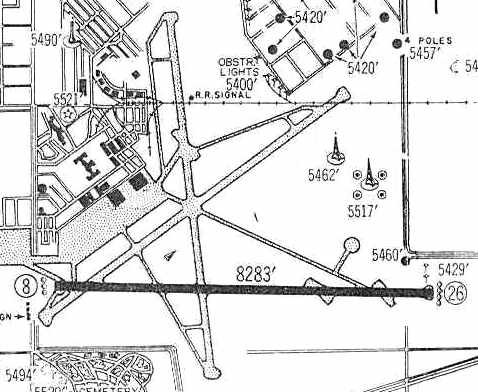
By the time of the 1960 Jeppesen Airway Manual (courtesy of Chris Kennedy),
Lowry was down to only a single remaining operating runway: the 8,283 paved Runway 8/26.
The two other abandoned runways were still depicted as well,
along with an extensive system of taxiways, ramps, and hangars.
In 1962, Lowry's Department of Weapons Training offered 60 courses in conventional munitions,
disaster control, armament, nuclear weapons, and weapons loading.
The Nuclear Weapons branch became the only Air Force organization
that instructed in storing, maintaining, assembling, testing, and handling nuclear components.

The June 1963 Denver Sectional Chart (courtesy of Chris Kennedy)
depicted Lowry AFB as having 3 paved runways, with the longest being 8,300'.
By 1964, Lowry's 3415th Technical School was graduating more than 10,000 people annually.

The last photo which has been located still showing aircraft operating from Lowry AFB was a 10/20/64 USGS aerial view.
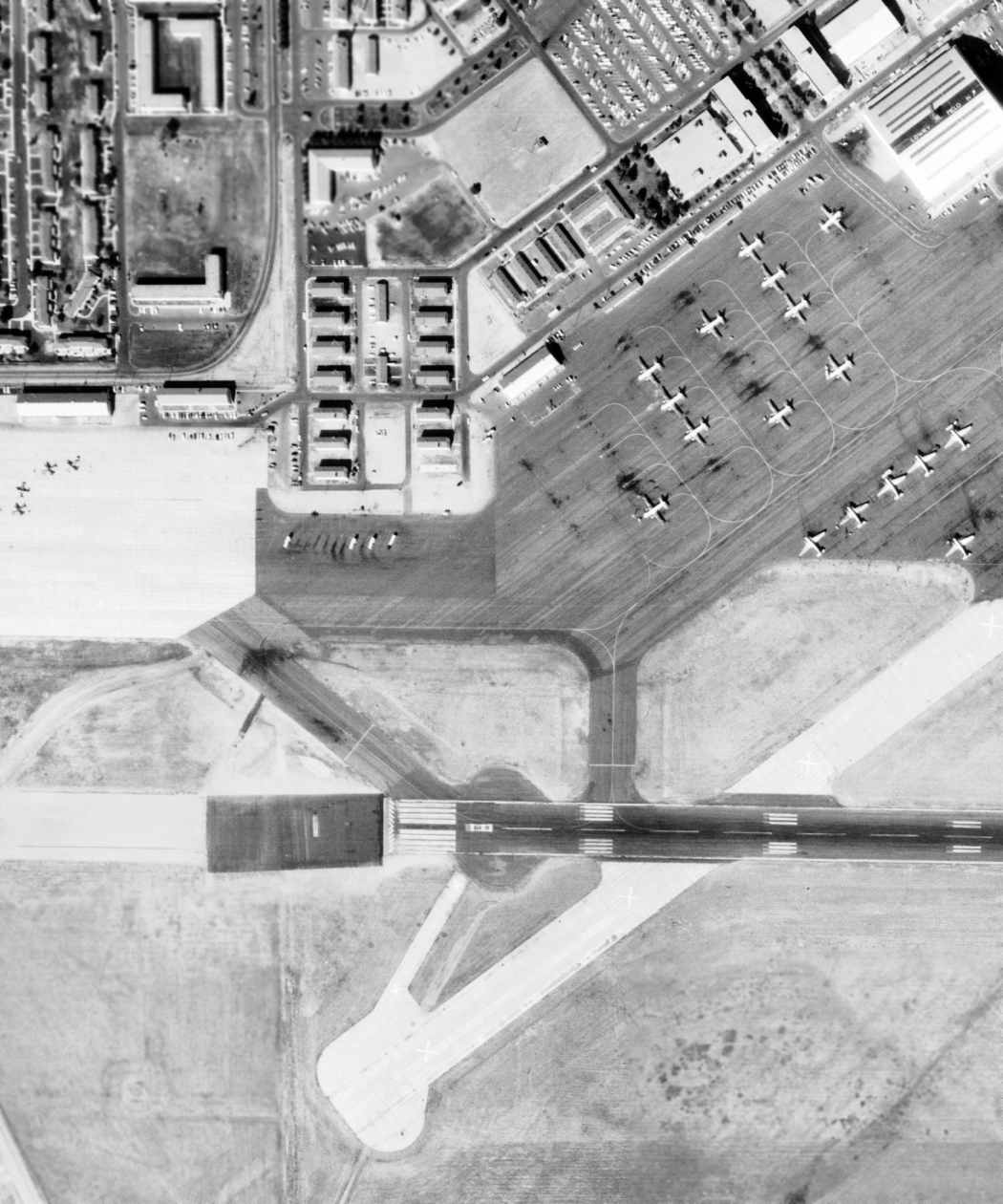
A closeup from the 10/20/64 USGS aerial view of Lowry, showing single-engine aircraft on the west ramp & larger twin-engine transports to the east.
In 1964 Lowry’s remaining flight operations were shifted to Buckley Field.
All flying activities ceased completely in June 1966
when the last T-29 was flown out of Lowry to Buckley.
By the time of the December 1968 Denver Sectional Chart (courtesy of Richard Doehring),
the 3 paved runways of Lowry were still depicted, but the field was labeled as Closed.
After the end of flight operations at Lowry, new programs were added.
Intelligence training returned, and airmen were trained for the Southeast Asia conflict.
The look of Lowry began to change in the 1970s.
Almost 200 WW2-era wooden buildings were replaced with brick structures.
The new facilities included five dormitories housing 1,000 people each,
a youth center, a child-care center, a chapel, an Airmen’s Open Mess,
and five buildings for the 3320thCorrection & Rehabilitation Group.
To put more emphasis on technical training & the aerospace mission,
the Air Training Command reorganized its schools in 1972.
The 3415thTechnical School became the USAF School of Applied Sciences - Lowry,
comprised of Avionics, Aerospace Photography, Aerospace Munitions, Special Instruments, and Logistics departments.
In 1976, the Air Force Accounting & Finance Center & the Air Reserve Personnel Center
opened in the Gilchrist Building (Building 444).

An undated aerial view looking north at Lowry AFB from the 1976 CO Airport Directory (courtesy of Alex Hauzer).
The February 1977 Denver Sectional Chart (courtesy of Chris Kennedy) still depicted the 3 former runways of Lowry AFB,
but the airfield was labeled as “Closed”.
In 1977, the Air Training Command was realigned along more traditional military lines.
Lowry’s school became the 3400th Technical Training Wing.
The training departments became technical training groups.
They were the 3420th Intelligence, 3430th Audiovisual, 3440th Logistics,
3450th Avionics, and 3460th Munitions groups.
The basic wing-group structure continued into the 1980s.
Lowry first faced the possibility of base closure in 1978,
but Air Force recommended keeping Lowry open.
With the base closure issue settled (for the time being),
Lowry Technical Training Center introduced new & improved courses for the 1980s.
Lowry became the primary training center for space operations courses
and began Undergraduate Space Training for officers.
Lowry also handled ground & armament training for the F-15, F-16, A-10, and B-1 bomber,
as well as the Short Range Attack Missile (SRAM).
Lowry was also instrumental in training munitions handling for modified B-52 bombers.
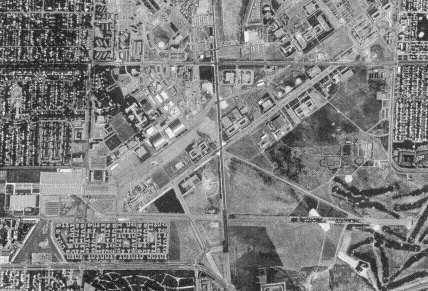
In the 1987 USGS aerial photo, the characteristic layout of Lowry's former runways was still apparent.
On October 1, 1987, Lowry observed its 50th anniversary.

The June 1989 Denver Terminal Chart (courtesy of Robert Brown) depicted still depicted the layout of Lowry's 3 runways.
Characterized by more reorganization, the 1990s saw the beginning of the end at Lowry.
The end of the Cold War, along with the resultant budget cuts & downsizing made base closure a reality.
In 1993, Lowry prepared to end 56 years of technical training.
While training continued, Lowry’s command structure planned to implement the closure in an efficient manner.
The Air Force deactivated the 3400thTechnical Training Group on April 27, 1994.
A parade & pass-in-review was planned,
but the death of former President Richard Nixon caused the ceremonies to be postponed to the 28th.
The official deactivation date, however, remained the 27th.
On September 30, 1994, the American flag came down for the last time at Lowry AFB,
almost 57 years to the day that it was first raised at a new base.
A non-profit foundation was created to form theWings Over The Rockies Air & Space Museum
which opened in the former Hangar #1 in 1994.
Today houses, office buildings, businesses, and paved streets
cover the land once occupied by hundreds of acres of concrete runways.
The only remaining hangar is presumably the former Hangar #1, which continues to house the museum.

A recent photo of a restored hangar at Lowry.
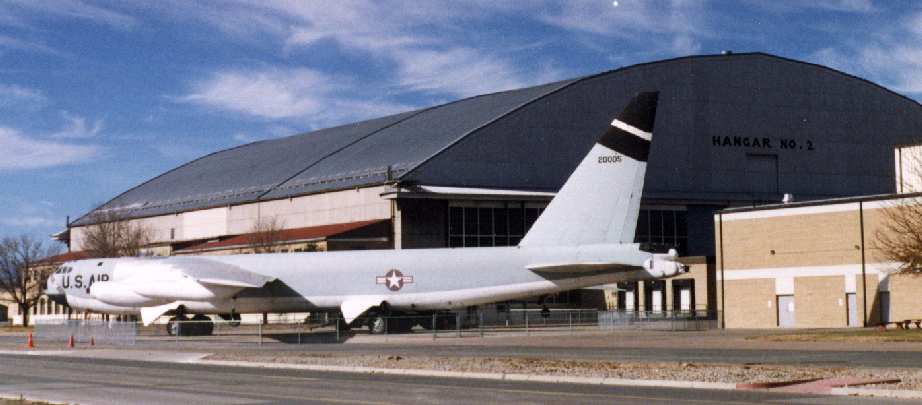
A 1999 photo by Lou Thole (author of the book "Forgotten Fields of America")
of a B-52 on display in front of Lowry's Hangar 2.

A 2002 photo by Tim Tyler of Lowry's Hangar #1.
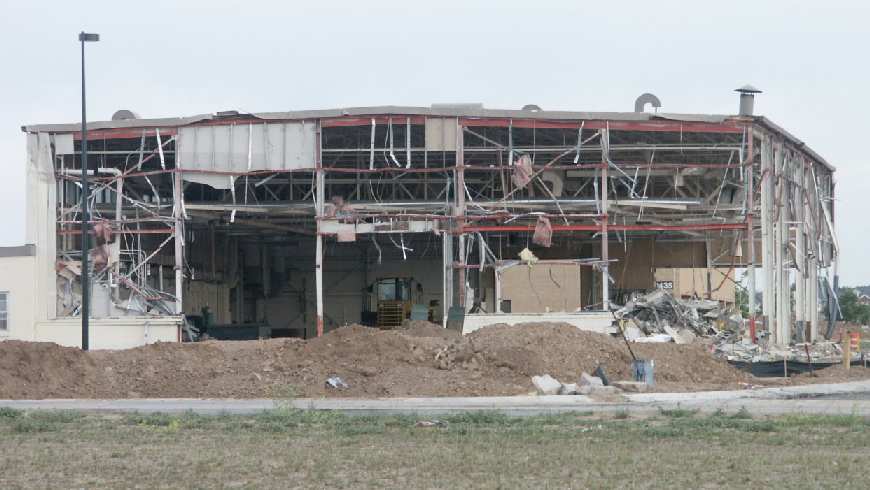
A 2002 photo by Tim Tyler of a building which was being demolished,
along the former flight line adjacent to Hangar #1.
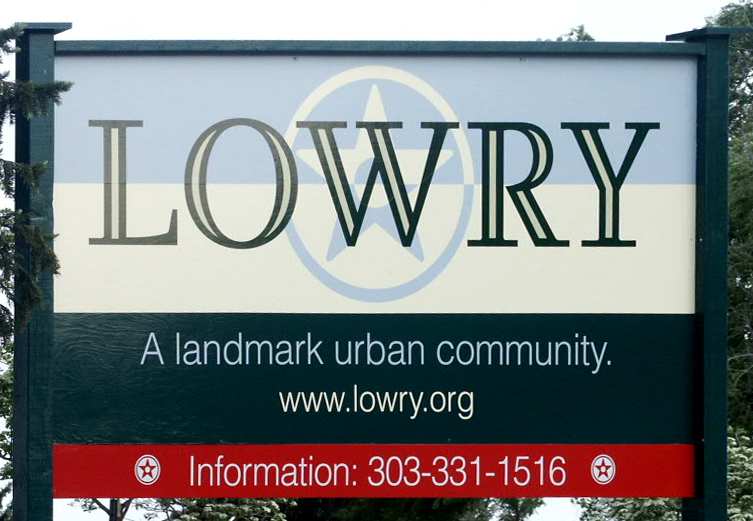
A 2002 photo by Tim Tyler of a sign at the development which is being built over a portion of the former Lowry AFB.
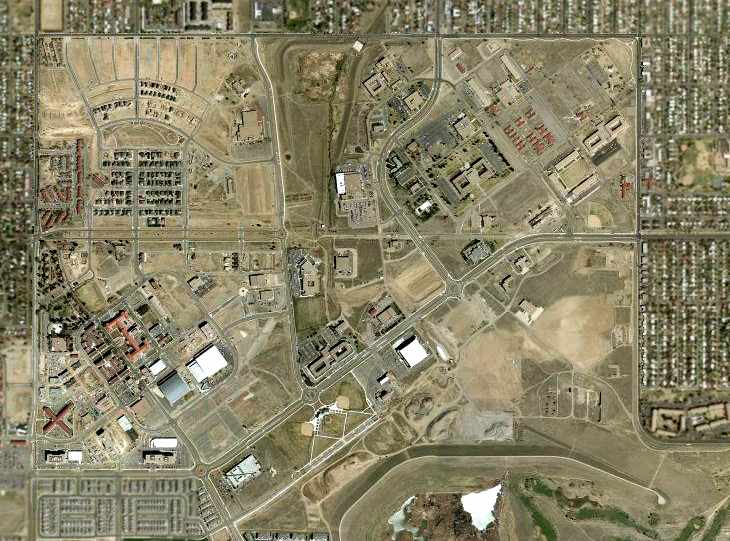
In the 2002 USGS aerial photo, some of Lowry's characteristic runway layout was still recognizable,
as well as the few remaining hangars.

A circa 2006 aerial view looking north at a B-52, an Adam A500, and a Learjet on display in front of Lowry's Hangar 1.
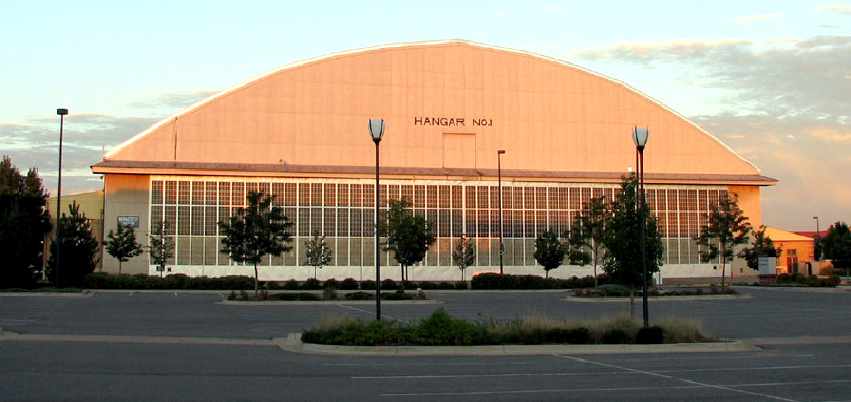
A 2007 photo by Scott Murdock of Lowry Field's former Hangar 1.
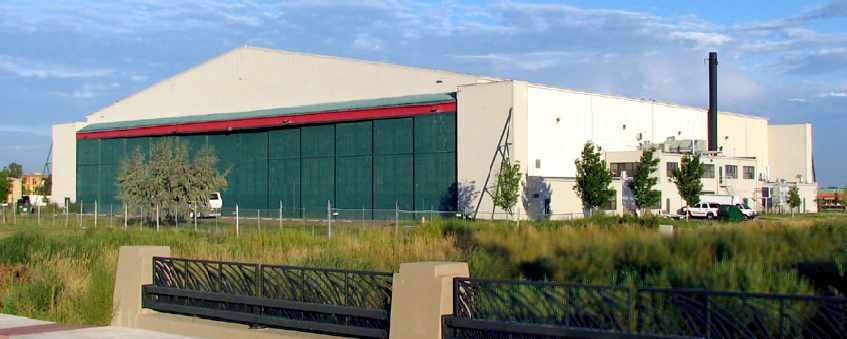
A 2007 photo by Scott Murdock of another former Lowry Field hangar.

A 2007 photo by Scott Murdock of 2 former Lowry Field hangars.
____________________________________________________
Since this site was first put on the web in 1999, its popularity has grown tremendously.
That has caused it to often exceed bandwidth limitations
set by the company which I pay to host it on the web.
If the total quantity of material on this site is to continue to grow,
it will require ever-increasing funding to pay its expenses.
Therefore, I request financial contributions from site visitors,
to help defray the increasing costs of the site
and ensure that it continues to be available & to grow.
What would you pay for a good aviation magazine, or a good aviation book?
Please consider a donation of an equivalent amount, at the least.
This site is not supported by commercial advertising –
it is purely supported by donations.
If you enjoy the site, and would like to make a financial contribution,
you
may use a credit card via
![]() ,
using one of 2 methods:
,
using one of 2 methods:
To make a one-time donation of an amount of your choice:
Or you can sign up for a $10 monthly subscription to help support the site on an ongoing basis:
Or if you prefer to contact me directly concerning a contribution (for a mailing address to send a check),
please contact me at: paulandterryfreeman@gmail.com
If you enjoy this web site, please support it with a financial contribution.
please contact me at: paulandterryfreeman@gmail.com
If you enjoy this web site, please support it with a financial contribution.
____________________________________________________
This site covers airfields in all 50 states.